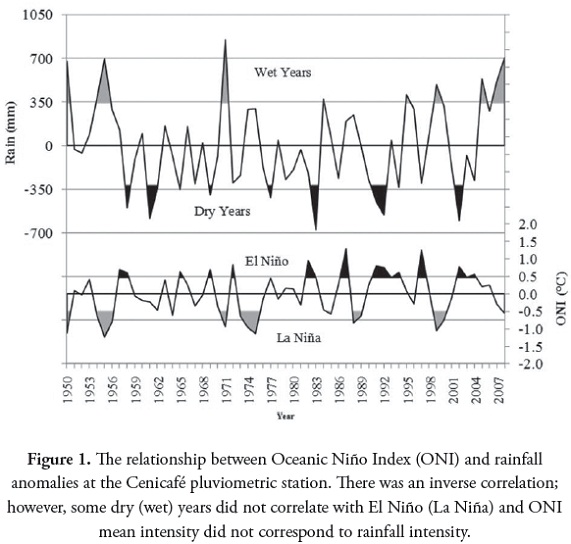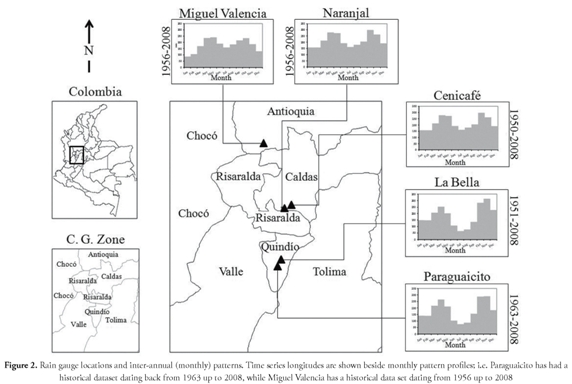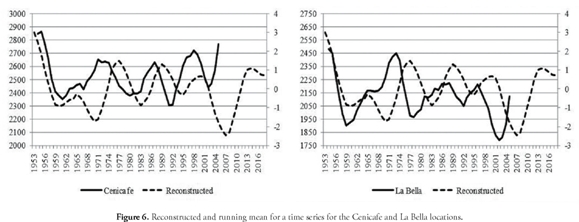Published
Detecting low frequency cycles in rainfall series from Colombian coffee-growing area by using descriptive methods
Detecting low frequency cycles in rainfall series from Colombian coffee-growing area by using descriptive methods
Andrés J Peña Q.1, Álvaro Jaramillo R.2 and María J Paternina Q.3
1 Disc. de Agroclimatología. Centro Nacional de Investigaciones de Café, CENICAFE. Km 4 vía antigua Chinchiná-Manizales. E-mail: Andres.Pena@cafedecolombia.com
2 Disc. de Agroclimatología. Centro Nacional de Investigaciones de Café, CENICAFE. Km 4 vía antigua Chinchiná-Manizales. E-mail: Alvaro.Jaramillo@cafedecolombia.com
3 Estudiante de especialización en estadística aplicada. Fundación Universitaria Los Libertadores. Bogotá. E-mail: mjpaterninaq@unal.edu.co
Record
Manuscript received: 20/04/2011 Accepted for publications: 05/12/2011
ABSTRACT
Descriptive statistical methods were used for improving climatic variability scenarios regarding rainfall using time series from five representative pluviometric stations (Miguel Valencia, Naranjal, Cenicafé, La Bella and Paraguaicito); such scenarios are used to make decisions regarding coffee-growing. The purpose was to find signs of cyclic behaviour besides those associated with El Niño Southern Oscillation (ENSO) which happens every 3.5 to 4.5 years. Signals were found of decadal to interdecadal cycle (10 to 30 years), modulating known ENSO effects related to periodic changes in the Pacific Ocean and solar activity.
Keywords: El Niño Oscilación del Sur (ENOS), Oscilación Decadal del Pacífico (ODP), series de tiempo, semivariograma.
RESUMEN
Con el objeto de mejorar la generación de escenarios de variabilidad climática, que son utilizados para tomar decisiones en el cultivo del café, se exploran en forma descriptiva las series temporales de lluvia medidas en cinco estaciones pluviométricas representativas de la zona cafetera colombiana (Miguel Valencia, Naranjal, La Bella y Paraguaicito) para encontrar señales de comportamiento cíclico, además del asociado con la Oscilación del Sur El Niño (ENSO), que es de 3.5 a 4.5 años. Se encontraron señales de ciclos de periodo decadal a interdecadal (10 a 30 años) que modulan los efectos ya conocidos del ENSO y que están asociados a cambios periódicos en el Océano Pacífico y la actividad solar.
Palabras claves: El Niño Oscilación del Sur (ENOS), Oscilación Decadal del Pacífico (ODP), series de tiempo, semi-variograma.
Introduction
Climate cycle detection is an ancient topic; our ancestors thought that our life was governed by the seasons' rhythms; it would thus be logical to think that it would be the same in the long-term (Burroughs, 2004). One can now speak about climate cycles being associated with changes in the sun (climate engine) and other cycles related to the ocean (climatic regulator).
The most studied cycles from the former group are the 11-year cycle associated with sunspots and the 22-year cycle related to changes in the sun's magnetic field (Burroughs, 2004). The most important cycle in the second group is the 3- to 4-year cycle related to El Niño Southern Oscillation (ENSO). Mesa et al., (1997) found that hydrology and rainfall in Colombia are usually affected by cycles related to changes in the tropical Pacific Ocean's surface temperature than by any other cycle. ENSO's local climatic effects have a defined pattern; rainy years are associated with La Niña (negative phase) and dry years with El Niño (positive phase), as described by Guzmán & Baldión (1997 and 1999). Nevertheless, some very dry or rainy years do not correspond to La Niña or El Niño, i.e. dryness or wetness intensity are not associated with Oceanic Niño Index (ONI) intensity (Figure 1).
Some authors have found that cycles having longer periods than ENSO could modulate this phenomenon's effect on climate; several authors have found cycles having a 10-40 year rainfall series period since the earliest part of the 20th century. The most important work in Colombia has shown 16-year (Peña, 1982) and 35-year (Poveda et al., 2002; Poveda, 2004) related to special phases in solar motion (Lands-cheidt, 2001) and Pacific Decadal Oscillation (PDO) peaks which could be affecting ENSO's effects on climate (Verdon & Franks, 2006). The purpose of this paper was therefore to assess rainfall time series at five locations having an annual dataset going back more than 46 years in the Colombian coffee-growing area (a rain-fed crop system) to detect other cycles, apart from ENSO, which could be used as predictable patterns for annual rainfall forecasting.
Simple methodological approximations based on moving averages and semivariograms were used as an alternative to periodograms, which have been shown to have problems when used for determining the presence of cycles and oscillations (Hernandez, 1999), and the autocorrelation function whose results would not have been appropriate in exploratory analysis because correlation level significance would not have been high and the aim was to identify signals not to quantify them. Moving averages with Burroughs filter (eq.1) were used as in the mathematical expression shown for (eq.2).


Using running means or moving averages was common practice in climatology; although this was a powerful tool for reducing short-term fluctuations in meteorological time series, it became unused because unweighted moving averages could be inappropriate for explaining periodicity (Lewis, 1960). Therefore, Burroughs (1978) proposed moving averages with filters to improve the smoothness of meteorological series. Function (eq.1) is known as a seven-year triangular filter and its great advantage lies in effectively suppressing high frequency elements. Kutzbach & Bryson (1974) explained the importance of non-high frequency components in a climatological time series. Weighted moving averages can show cyclical time series' behaviour. However, the semivariance function was also used here for improving results. This function is used in geostatistics to evaluate spatial correlation (structural analysis); it was used here as a temporal correlation estimator. This function was thus estimated with the experimental semi-variogram calculated according to Wackernagel (1995), as shown in (eq.3).
Data and Methodology
Five rain gauges were chosen having historical annual data sets going back a long way; they formed part of the Colombian Federation of Coffee Growers' meteorological network. The rain gauges were located in the coffee-growing area (C.G. Zone), between 4°24' N (Paraguaicito Station) and 5°36' N (Miguel Valencia Station) at different heights above sea level (in meters, masl) (Figure 2).

where Z(x) is the value in x time, Z(x+h) is a value separated by h time from the previous value and n is the pair's number separated by this time (and it is not constant). Semivariograms were drawn using a semivariance/ sample variance ratio on the y-axis to have the same scale at all locations. As opposed to a geostatistical approach, where the aim is to fit a model to the experimental semivariogram to be interpolated, semivariograms were used in this work to detect signs of cyclical behaviour, i.e. it was used as a descriptive tool. Semivariance function could thus be inversely interpreted regarding the correlation function; when there is high semivariance there is a negative correlation, when semivariance is close to one there is no correlation, whereas there is positive correlation if there is low semivariance. Thus when there is cyclical behaviour, a semivariogram having high to low semivariance oscillations is expected when distance (time, in this case) becomes increased.
Discussion and Conclusions
Figure 3 shows the annual rainfall's cyclic pattern recorded at five stations. Consecutive wet years alternated with consecutive dry years; the wettest periods in the area were 1971-1977 and 1996-2002 and the driest periods were 1977-1983 and 1989-1995. There was an exceptional period having greater annual rainfall in the longer time series: 1951-1957.
Overall, 12 to 18 years between crests (rainy years) were noticed in weighted time series. In spite of the fact that there were more "La Niña" months (and more intense cooling in the Pacific Ocean) between 1971 and 1977 than between 1996 and 2002, the latter period was rainier regarding 1971-1977. It was not related to ENSO effects, at least not completely because when "La Niña" occurred there was greater rainfall in the area (Guzman & Baldión, 1999). Similar results were obtained when the driest periods were analysed; there were less "El Niño" months between 1977 and 1983 than between 1989 and 1995; however, the dry period was longer after 1977.
Figure 4 shows signs of periodical variability in annual rainfall time series. Three signals (decadal, bi-decadal and interdecadal) occurred at almost all stations which other authors have associated with sunspots (Burroughs, 2004; Hiremath, 2006), solar magnetic cycles (Almeida, 2004) and ocean phenomena such as PDO and North Atlantic Oscillation (NAO) (Poveda, 2004; Tourre et al., 2001). Three hypothetical time series (n=65) were calculated for each signal (11, 21 and 33 years), having values between -1 and 1 to obtain a reconstructed series by summing representing mean annual rainfall pattern in the area (Figure 5).
The reconstructed series representing mean annual rainfall pattern (Figure 5d) was compared to the smoothed time series (running means with Burroughs filter) for La Bella and Cenicafé locations. A relationship was found between running mean series and bit-lagged reconstructed series (Figure 6).
The results showed that signs of low frequency cycles could be detected in annual rainfall series by using simple statistical methods related to a description of variability and that there were relevant cycles in rainfall series which could have been modulating ENSO effects. This occurred because sea surface temperature time series' semivariance function (Equatorial Pacific Ocean) was related to ENSO phenomenon, showing signs of cycles having one- and three-decade periods as rainfall series (Figure 7), whereas a two-decade cycle would mostly be related to an 18.5 year cycle associated with the PDO's moon-tidal cycle (Currie, 1991; Yasuda, 2009).
References
Almeida, A., Gusev, A., Mello, M., Martin, I., Pugacheva, G., Pankov, V., Spjeldvik, W. and Schuch, N. (2004). Geofísica Internacional. 43, no. 2, 271-279.
Burroughs, W. (1978). On running means and meteorological cycles, Weather. 33, no. 3, 101-109.
Burroughs, W. (2004). Weather Cycles: Real or Imaginary?, Cambridge University Press, Cambridge, UK, 317 p.
Currie, R. G. (1991), Luni-solar 18.6-year signal in tree-rings from Argentina and Chile, Pure and Applied Geophysics. 137, no. 3, 281- 300.
Guzman, O. and Baldión, V. (1997). El evento cálido del Pacífico en la zona cafetera colombiana, Cenicafé. 48, no. 3, 141-155.
Guzman, O. and Baldión, V. (1999). Influencia del evento frío del Pacífico en la zona cafetera colombiana, Cenicafé. 50, no. 3, 222-237.
Hernandez, G. (1999). Time series, periodograms and significance, Journal of Geophysical Research. 104, no. A5, 10355-10368.
Hiremath, K. (2006). The influence of solar activity on the rainfall over India: Cycle-to-cycle variations, Journal of Astrophysics and Astronomy. 27, no. 2-3, 367-372.
Kutzbach, J. and Bryson, R. (1974). Variance spectrum of Holocene climatic fluctuations in the North-Atlantic sector, Journal of Atmospheric Science. 30, no. 8, 1958-1963.
Landscheidt, T. (2001). Trends in Pacific Decadal Oscillation subjected to solar forcing, Internet site of the Institute for Research in Cycles of Solar Activity, http://www.john-daly/theodor/pdotrend.htm (last accessed November 2010).
Lewis, P. (1960). The use of moving averages in the analysis of time series, Weather. 15, no. 4, 121-126.
Mesa, O., G. Poveda and F. Carvajal. (1997). Introducción al clima de Colombia, Universidad Nacional de Colombia, Medellín, Colombia, 390 p.
Peña, D. (1982). Algunas características de la precipitación en Palmira (Colombia), Turrialba. 32, no. 3, 219-228.
Poveda, G., Velez, J., Mesa, O., Hoyos, C., Mejía, F., Barco, O. and Correa, P. (2002). Influencia de fenómenos macroclimáticos sobre el ciclo anual de la hidrología colombiana: cuantificación lineal, no lineal y percentiles probabilísticos, Meteorología Colombiana. 6, 121-130.
Poveda, G. (2004). La hidroclimatología de Colombia: una síntesis desde la escala inter-decadal hasta la escala diurna, Revista Academia Colombiana de Ciencias. 28, no. 107, 201-222.
Tourre, Y., Rajagopalan, B., Kushnir, Y. and Barlow, M. (2001). Patterns of coherent decadal and interdecadal climate signals in the Pacific Basin during the 20th century, Geophysical Research Letters. 28, no. 10, 2069-2072.
Verdon, D. and Franks, S. (2006). Long-term behaviour of ENSO: Interactions with the PDO over the past 400 years inferred from paleoclimate records. Geophysical Research Letters, 33, L06712, doi:10.1029/2005GL025052.
Wackernagel. H. (1995). Multivariate Geostatistics. An Introduction with Applications, Springer-Verlag, Berlín, Germany, 389 p.
Yasuda, I. (2009). The 18.6-year period moontidal cycle in Pacific Decadal Oscillation reconstructed from tree-rings in western North America. Geophysical Research Letters, 33, L05605, doi:10.1029/2008GL036880.
How to Cite
APA
ACM
ACS
ABNT
Chicago
Harvard
IEEE
MLA
Turabian
Vancouver
Download Citation
Article abstract page views
Downloads
License
Earth Sciences Research Journal holds a Creative Commons Attribution license.
You are free to:
Share — copy and redistribute the material in any medium or format
Adapt — remix, transform, and build upon the material for any purpose, even commercially.
The licensor cannot revoke these freedoms as long as you follow the license terms.
The Earth Sciences Research Journal is the copyright holder for these license attributes.






























